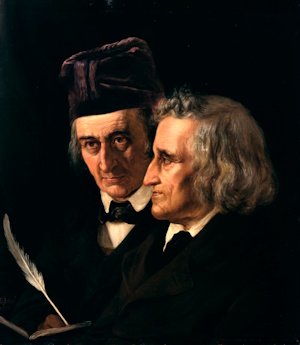< Library |
Index |
1st story > |
Children's and Household Stories
Commonly known as Grimms' Fairy Tales
 Numerical index Numerical index |
 Alphabetical index Alphabetical index |
 Deutsch Deutsch |
 Italiano Italiano |
 Português Português  |
| Library |
Ancient European folk tales were transcribed from local storytellers by the Grimm brothers in the early 19th century.
Who were these brothers and what do the stories mean?
Who and what?
Jakob Ludwig Grimm (1785-1863) and his slightly younger brother Wilhelm Karl Grimm (1786-1859) were two university professors of linguistics, best known for their collection of fairy tales, several of which are still popular today. Since the copyright has long expired, some of the more popular stories have been adapted for movies and video games, in addition to the traditional ballet and pantomime.
These include:
- Cinderella
- Hansel and Gretel
- Rapunzel
- Rumpelstiltskin
- Sleeping Beauty
- Snow White and the Seven Dwarfs
- The Frog King
The stories reproduced on this website include a few notes of our own; mainly short explanations and modern equivalents of archaic terms. We have left the "whither goeth thou" type of phrase undisturbed, since they are reminders of the period in which the stories were written and probably no trouble for most readers. Some terms, however, have less obvious meanings and it's those we have annotated.
And that's about all.
No reams of scholarly analysis and opinion; just the stories.
Why?
Some of the stories today seem quite bizarre and leave most people befuddled over the reason the Grimms decided to record them. Maybe "it's the way you tell 'em". Or maybe they had no meaning.
For the Grimm brothers, the meaning was of secondary importance to the stories' linguistics.
The brothers collected tales from several sources, tailored them to a common style, and published their first edition of Children's and Household Stories (Kinder und Hausmärchen) in 1812 and the final (seventh) edition in 1857. The stories were published with several notes, as one might expect from linguists. Their intention was to record more 'how' the stories were told, rather than 'what' the stories meant. The Brothers also published a condensed version especially designed for children but their major work was for language scholars.
If a story does have meaning, and what that meaning might be, is for the reader to determine. There are clear lessons for children on the perils of cheating, lying, stealing, unfaithfulness, talking to strangers, etc., which all sound laudable. And though much of the brutality of the original German version has been softened in the English translation, there remain reminders that every stepmother in the world is a wicked witch, that it's OK for old men to sleep with young maidens, and it's quite acceptable to chop off somebody's head.
Antisemitism
Despite the obvious Jewish-ness of Jakob's name, the stories' antisemitic and racist references did not escape the attention of the Nazis before and during WWII. Kinder und Hausmärchen were held to be model stories for the next generation of good Germans to study.
The Third Reich were also impressed with the German Nationalism they could see in the brothers' other works. These included Jakob's Deutsche Grammatik (German grammar) published in 1918, Deutsche Rechtsaltertümer (German Legal Antiquities) 1928, Geschichte Der Deutschen Sprache (History of the German Language), 1848, Wilhelm's Die Deutschen Heldensagen (The German heroic sagas) 1829, and Deutsche Mythologie (German / Teutonic Mythology) 1835.
The Grimm brothers cannot be blamed for the rise in Nazism, any more than other inspirers, such as Charles Darwin and his (later recounted) evolutionary theories that gave a 'scientific' framework for Hitler's Eugenics programme. Martin Luther, leader of the German Reformation, wrote vile attacks on Judaism which appealed to Nazis, and Adolf Hitler was a great admirer of Wagner's music and his publicly proclaimed anti-Jewish sentiments.
Despite all this, the Grimm Brothers were perhaps no more antisemitic than many other people at the time. Like much of Europe, Germany was changing economically and politically with the spreading Industrial Revolution. They were exciting and fast moving times; some people benefitted greatly whilst others suffered harshly. And when you are downtrodden, it is natural to seek a scapegoat. The Jews just happened to be a minority with a long history of being prejudiced against.
Like many devout people, their ways seemed strange to Gentiles, were misunderstood and were unacceptable. There are significant philosophical and theological differences between Christianity and Judaism, which quite frankly didn't and doesn't bother most people.
What is irksome, however, is when one group corners a market for a particular commodity, or owns something the other group desires. This is more to do with differences in culture rather than religion. Black Africans were subjugated, not because of their Pagan religion and not because the Christian Church determined they were bearers of original sin. If they became Christian they were still slaves to the white man, and this is simply because they were easy prey. (See Racism in the Church)
The stories on this website
But let's leave this heavy background; enough has been said already.
As mentioned at the top of this page, the stories have been reworked so many times over the past 200 years and it's time to get back to the original version.
Read each story as it is, and enjoy it. Think about possible deep meanings if you wish, or just click on one of the many associated links which will lead you to a related joke.


